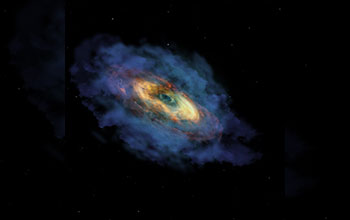Multimedia Gallery
Formation of the quasar Pōniuāʻena
An artist’s impression of the formation of the quasar Pōniuāʻena starting with a seed black hole, 100 million years after the Big Bang. Astronomers discovered Pōniuāʻena, the second most distant quasar ever found, using the international Gemini Observatory and Cerro Tololo Inter-American Observatory.
[Research supported by U.S. National Science Foundation grant AST 1907290.]
Learn more in the NOIRLab news story Monster black hole found in the early universe. (Date image taken: unknown; date originally posted to NSF Multimedia Gallery: Aug. 10, 2020)
Credit: International Gemini Observatory/NOIRLab/NSF/AURA/P; Marenfeld
Images and other media in the National Science Foundation Multimedia Gallery are available for use in print and electronic material by NSF employees, members of the media, university staff, teachers and the general public. All media in the gallery are intended for personal, educational and nonprofit/non-commercial use only.
Images credited to the National Science Foundation, a federal agency, are in the public domain. The images were created by employees of the United States Government as part of their official duties or prepared by contractors as "works for hire" for NSF. You may freely use NSF-credited images and, at your discretion, credit NSF with a "Courtesy: National Science Foundation" notation.
Additional information about general usage can be found in Conditions.
Also Available:
Download the high-resolution JPG version of the image. (2.6 MB)
Use your mouse to right-click (Mac users may need to Ctrl-click) the link above and choose the option that will save the file or target to your computer.

 All images in this series
All images in this series